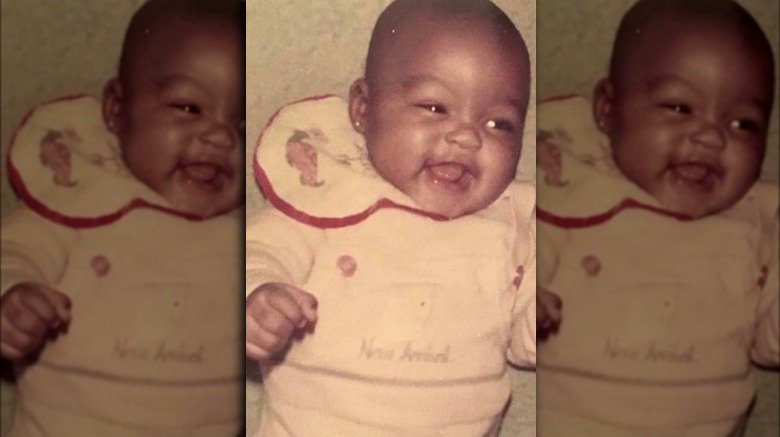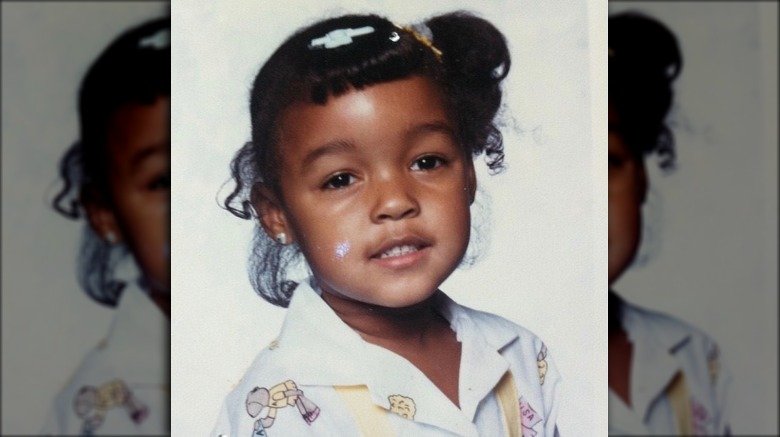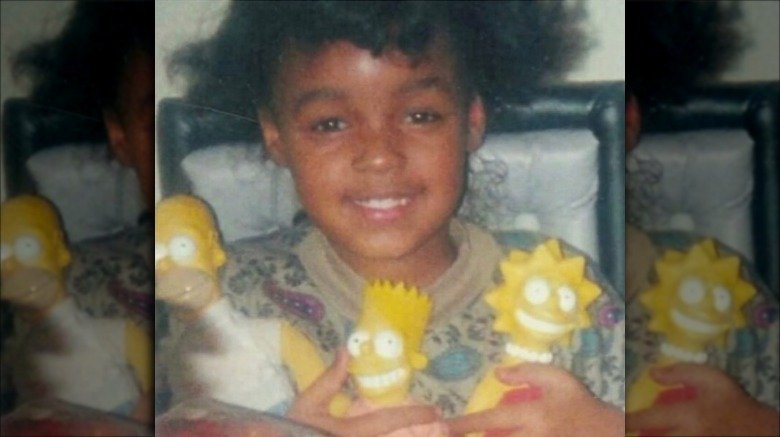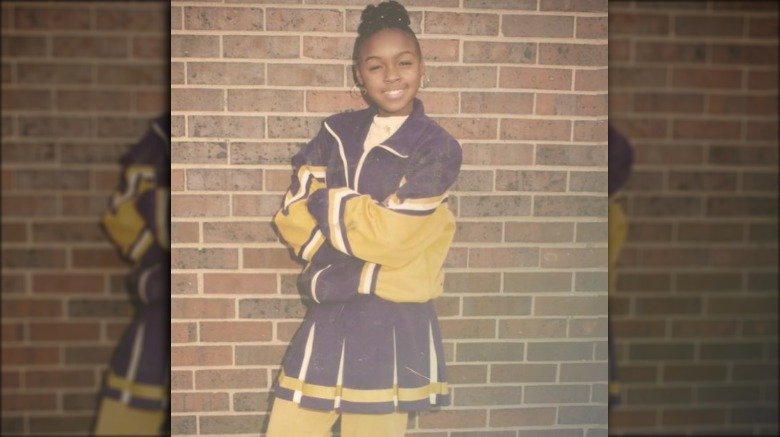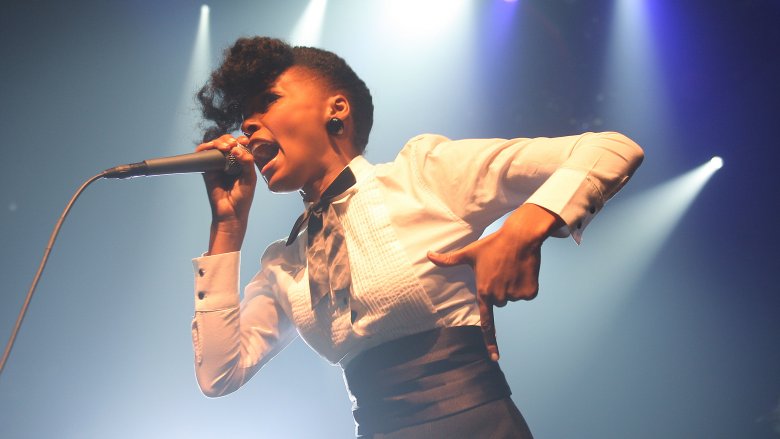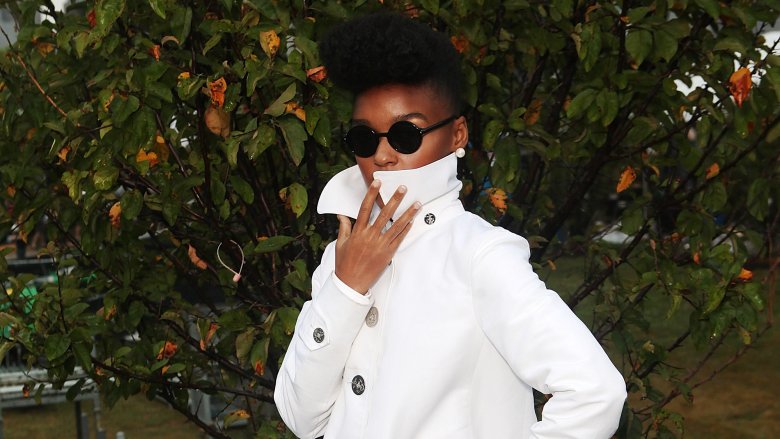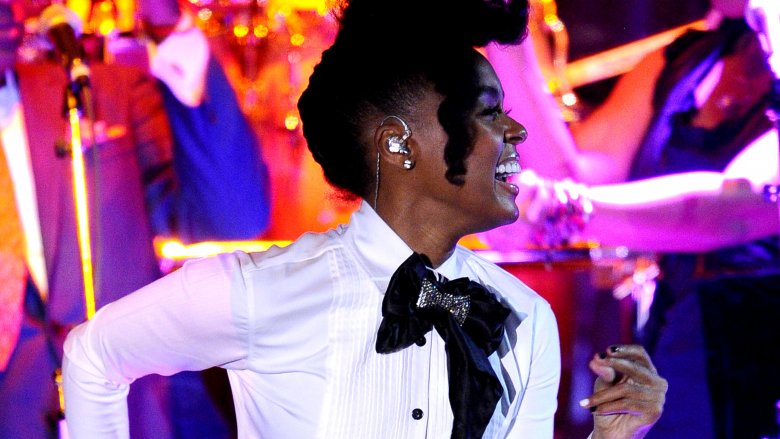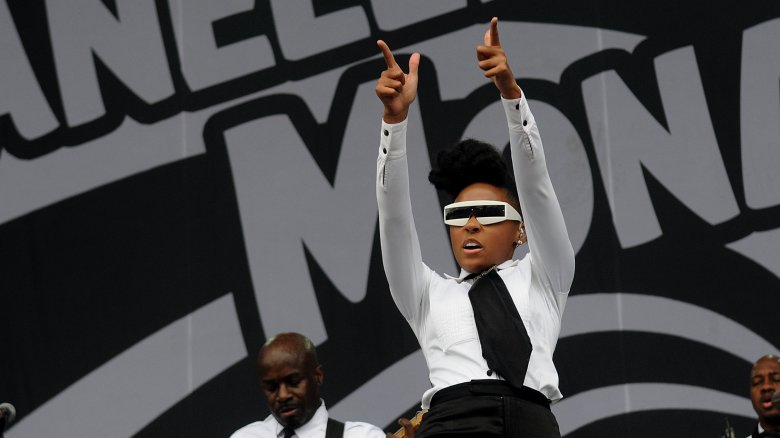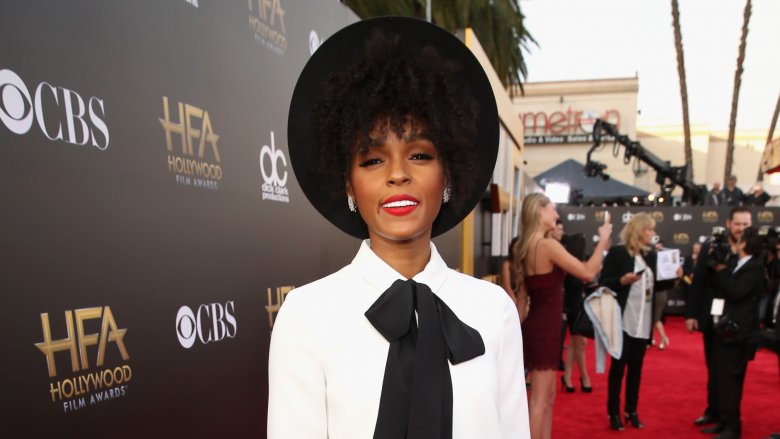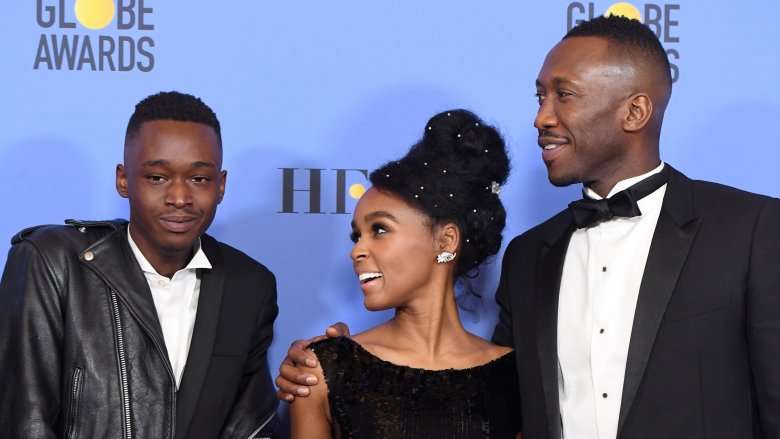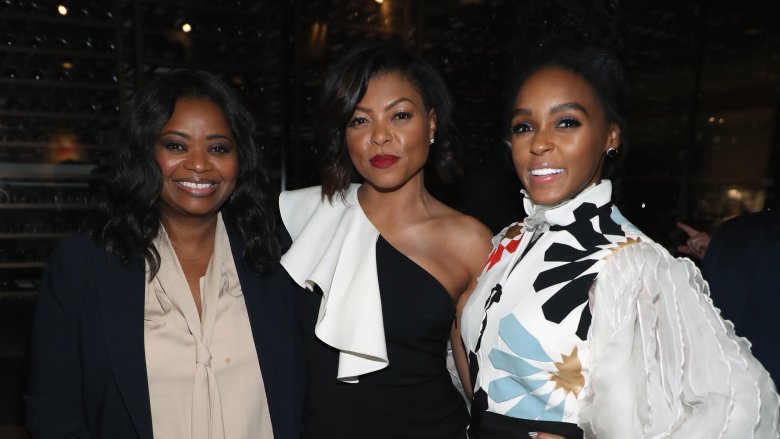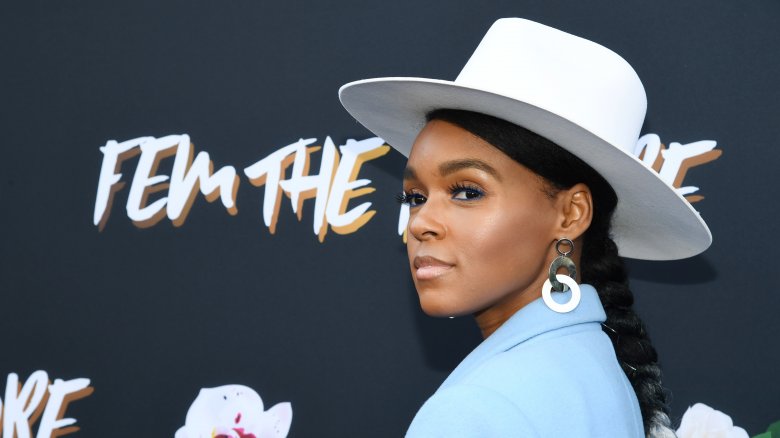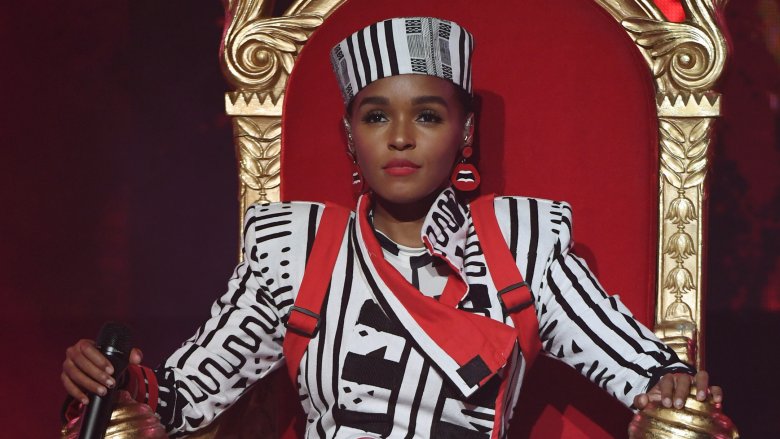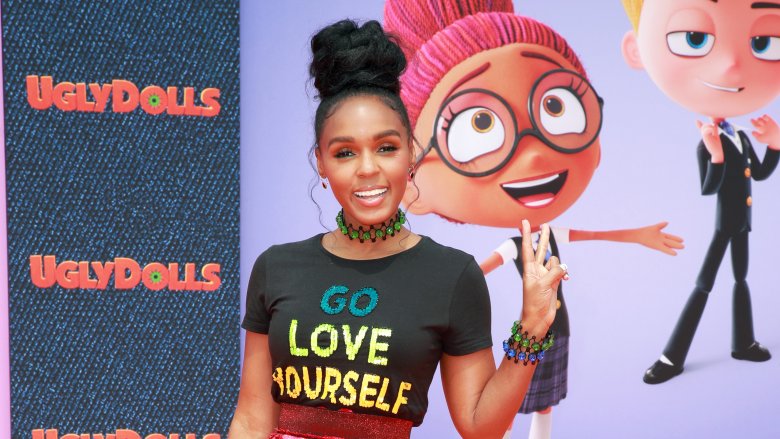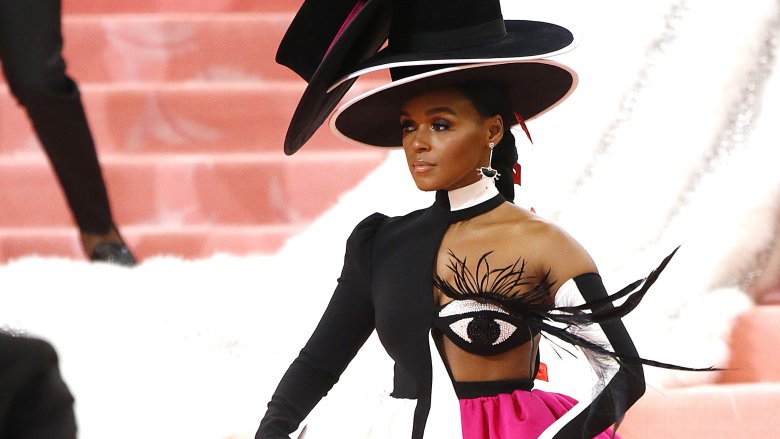The Stunning Transformation Of Janelle Monae
Some say that Janelle Monáe is an amalgam of two of her late heroes, science fiction writer Octavia Butler and gender-bending musician extraordinaire Prince, the latter of whom was a friend of hers. But to simplify Monáe as such, even as a combination of two extraordinary people, doesn't tell the full story. The musician, actress, and performance artist contains multitudes, which is apparent in her concept albums, film appearances, and, of course, her concert performances. Monáe's work has garnered her many honors, including multiple Grammy Award nominations and a host of other awards and noms.
But Monáe didn't fall from the sky, or make her entrance on the earth from a futuristic space ship, as surprisingly plausible as that might seem. Rather, she has a classic American origin story, complete with family struggles and big dreams that propelled her seemingly inevitable ascent into celebrity. So just who is the woman behind the androgynous android exterior? How did she evolve into the multi-talented star that she is today? Read on to learn about the stunning transformation of Janelle Monáe, from her childhood into her adulthood.
Humble beginnings in Quindaro
It's not another solar system that you'd need to visit to see where Monáe was born in 1985, or even another planet in our own. Rather, Monáe is a native of the Quindaro community of Kansas City, a settlement founded by Native Americans and abolitionists that became a haven for African Americans, according to Rolling Stone magazine. He mother was a janitor, and she and Monáe's father split up before the future artist turned a year old. Monáe's mother later remarried.
Additionally, Monáe's father struggled with substance abuse issues for decades, something that had an impact on her growing up. "My father is a recovering crack addict — he was in and out of prison — so I've seen the ups and downs of drug addiction," she shared in another interview with Rolling Stone. "Things were taken from us growing up — I would win like $500 in a talent show and I had to give it to my mom to help pay for the light bill and the gas bill." That sounds really rough — no wonder Monáe avoids drugs at all cost.
Fortunately her father has been in recovery for many years, and they have repaired their relationship.
She grew up surrounded by family
Despite her father's struggles with addiction while Monáe was growing up, there was no shortage of family around her to envelop her within a loving environment. During her childhood, Monáe lived in a house owned by her maternal grandmother, who also housed the singer's aunts, uncles, and cousins in other houses she owned — all in a row on the same street, according to Rolling Stone. Not far away, her paternal great-grandmother lived in a pastel-colored home, where Monáe spent a lot of time as a child. Given that her parents were not together, Monáe was able to connect with her father when he was in and out of prison while at that house. Additionally, one of her maternal aunts lives just a few minutes away.
The community where Monáe came of age was predominantly black, while, just across the bridge in Missouri, Kansas City was mostly white, something that's not lost on her. "I would read about where I was from, and understand who's really disadvantaged coming from these environments," she recalled. "It sucks. It's like that for brown folks." Certainly some real changes are needed.
Born to be a star
Monáe was destined to become famous, and it was readily apparent to her family at a very young age, according to Rolling Stone. For example, she performed parts of The Miseducation of Lauryn Hill at the Juneteenth talent show for three years in a row and won every time. She also snagged the lead parts in school musicals, except in one case where she had to run an errand and leave the audition before it was finished. Monáe was even kicked out of church once for breaking into a rendition of "Beat It" by Michael Jackson in the middle of the service. Clearly her artistic abilities could not be contained!
In addition to all of that, Monáe was also a participant in a young playwrights' program as a teenager, according to The New York Times Magazine. So, by the time she graduated from high school in the early 2000s, she was presumably ready to see where her talents would take her next.
Taking a bite out of the Big Apple
Once she was finished with high school, Monáe was ready to take the next step in her development. After learning that she was successfully admitted to the American Musical and Dramatic Academy in New York City, she headed off to the Big Apple to study musical theater, according to The New York Times Magazine. That's a long way from Kansas, y'all.
During her tenure in the city, Monáe shared a room with her older cousin at Amsterdam and 140th, as she was unable to afford to live on campus. Her cousin worked the night shift at the post office, so the two slept in shifts in their small apartment. That's some NYC realness for you right there — the rent is not cheap!
Monáe did receive some financial help from her church congregation to get by, and she supplemented that by working shifts as a maid. When she wasn't working, you were likely to find her reading scripts and reciting speeches at the library, immersed in her academic study. But it wasn't long before something else came calling, which lured her away from the city that never sleeps.
A fresh start in the ATL
While Monáe was making a go of it in New York, one of her best friends was studying at a historically black college down in Atlanta — and that friend told Monáe all about it, according to The New York Times Magazine. After hearing about the camaraderie her friend was experiencing there, as well as the lifestyle that comes with HBCU life, Monáe decided it was time to leave New York a year and a half after she'd first arrived. "I wanted to really feel inspired and start things with Janelle Monáe," the singer recalled in an interview with The Quietus, adding, "I didn't want to get dictated to by anybody, except for just listening to and accomplishing my own heart, to get in contact with the things that made me unique." It was time for her to fly, for sure.
Once Monáe settled in Atlanta, it quickly became apparent that it was the right move. "There are so many other likeminded individuals in Atlanta," she continued. "I have a creative family down there — it consists of visual artists, performance artists, screenwriters, graphic novelists — you name it, they help make Atlanta special for me." And it was there that she truly thrived.
Adding Afro-futurism to Bad Boy
It didn't take long after Monáe moved to the ATL for her to find her groove. She moved into a boardinghouse, established an art collective, enrolled at Georgia State University's Perimeter College, and began working on her own music, according to The New York Times Magazine. Monáe also recorded a CD that she distributed, performed on campuses, and uploaded her music to her Myspace page.
After that, Monáe began to get noticed by the big shots in the local music scene, including Big Boi from Outkast. That, in turn, caught the ear of none other than Sean Combs (known as Puffy at the time), who was immediately interested in her work. "I just knew she was going to be important to music and culture," he shared. "It was the same sort of feeling I had when I first heard Biggie or Mary J. Blige, and I wanted to help introduce this artist to the world." That's some high praise!
Although Monáe was hesitant, having been burned by record execs before, she agreed to let him see her perform her EP Metropolis which he loved. She signed to Bad Boy Records in 2008.
The ArchAndroid emerges
Now well-established in the Atlanta arts scene, Monáe set to work on creating her first full-length album, The ArchAndroid, which was released in 2010. The album continued the sonic journey of Cindi Mayweather, Monáe's alter-ego, who was born on the Metropolis EP — thanks to the help of her collaborators Nate "Rocket" Wonder and Chuck Lightning. "We love the film industry and everything that's about creating a big idea, a concept album," she explained in an interview with The Quietus. "We're into movies, and we wanted to create an 'emotion picture' with The ArchAndroid, so we did that." That sounds truly epic.
Meanwhile, door after door was opening for Monáe. She toured with music juggernauts No Doubt and Bruno Mars, became a CoverGirl model, and collaborated with Erykah Badu and Solange Knowles, as noted by The New York Times Magazine. In addition, she found a truly royal mentor: Prince. "He said he wanted to give me advice before I got too involved within the industry," she shared with Rolling Stone. "And that if I ever needed to speak with him, he's always available." Talk about a dream come true!
Monáe and Prince remained friends until his untimely passing in 2016.
Behold The Electric Lady!
Three years after dropping her first full-length album, Monáe released her second album in 2013, The Electric Lady. Born out of self-exploration and a curious desire to paint the same female form for months in a row, Monáe found the name for the album in a conversation with her therapist. "What I wanted to do was create an album that deals with this concept of the Electric Lady," she revealed in an interview with Billboard. "And a world where these electric ladies were realizing their super powers and doing self-realization into self-actualization and nurturing the community through their gifts and their unique perspectives on life." Raise your hand if you are completely here for this!
Solange Knowles, Prince, Miguel, Esperanza Spalding, and Erykah Badu all collaborated with Monáe on the album, on which she showcased the true breadth of R&B. "Musically I wanted to create an album that was rooted in R&B but make sure I was capturing the diversity in R&B music," she continued. That she did, and she performed it in front of thousands of fans on a North American tour. Her epic ascent to stardom was full steam ahead.
An Oscar-winning film debut
While Monáe was busy killing it in the music industry, movie scripts began arriving in her mailbox. But it wasn't until 2016 that she made her film debut in the 2017 Academy Award winner for best picture, Moonlight, directed by Barry Jenkins. Monáe starred opposite Mahershala Ali's Juan in the role of Teresa, who together provide a young Chiron (Ashton Sanders) with a loving space where he is safe from both bullies and his mother's neglect.
Monáe connected instantly with the script, which resonated with her deeply. "I had a strong visceral reaction to the Moonlight script, partly because I felt I knew all of these characters," she revealed in an interview with The Guardian. For example, Chiron reminded her of one of her cousins, she had a family member who struggled with crack addiction, and, in her neighborhood growing up, there was a drug dealer like Juan.
Additionally, the role of Teresa was not an unfamiliar one for her. "I've played the role of Teresa in real life: my family and friends always have a shoulder to lean on with me," she continued. There's little doubt that she was the perfect person for the part.
Breaking ground with Hidden Figures
Moonlight wasn't the only film Monáe starred in during 2016 that received a ton of Oscar buzz. That same year, she starred alongside actresses Octavia Spencer and Taraji P. Henson in Hidden Figures, a critically acclaimed and Academy Award-nominated film about three black female mathematicians who played vital roles in the NASA space program in the 1960s. Based on a true story, the film brought the lives of Katherine G. Johnson, Dorothy Vaughan, and Mary Jackson to the big screen for the first time — and showed just how important their work was in a time when they faced serious barriers because of their race and sex.
Monáe signed on for the film for many of the same reasons she accepted a role in Moonlight: to uplift the LGBT community, empower women, and showcase "the other." In an interview with Atlanta magazine, she explained, "As an artist, I want to ensure that moviegoers see different kinds of black women being portrayed on-screen." She continued, "Representation in film is extremely important. I knew I had to drop what I was doing to be a part of them." We're glad she did.
Femming up the future
On top of having a successful music career and scoring starring roles in major films, Monáe is also an activist and advocate. She's attended protests for the Black Lives Matter movement, released a protest anthem called "Hell You Talmbout" in support of the black men and women who were killed by police officers and vigilantes, and threw her support behind Hillary Clinton in the 2016 presidential election. Obviously, Monáe is not afraid to speak her mind, especially on issues that matter dearly to her.
In addition, Monáe also created a grassroots nonprofit called Fem the Future, with the goal of creating employment opportunities for women who are in the arts. "[I wanted] to create a platform to shine light on women and their talent, whether it's behind the scenes or in front of the camera," she explained in an interview with Ebony magazine. She noted, "A beautiful future is a future where women are included in [all] different aspects." That is truly a noble undertaking, and one that puts women first.
Dirty Computer and coming out as queer
In April of 2018, Monáe dropped an album that shook the music industry from the ground up: Dirty Computer. The Grammy-nominated record is the third full-length release from Monáe, and it was accompanied by a 48-minute long film of the same name. The album features an impressive list of collaborators, such as Pharrell Williams, Brian Wilson, Zoë Kravitz, and Grimes, and the influence and legacy of Prince is palpable.
Not only is the album star-studded and critically acclaimed, but it's also the first time Monáe put herself out there as a completely stripped down human instead of as an android. And she came out as queer. "When I come home at night and take off my makeup and my performance uniform, I still am a young, black, queer woman from America who grew up with working class parents," she proclaimed in an interview with Billboard. "So it was just important to speak from that perspective and, in the process, let people know that it was important for Dirty Computers to feel like we have a community." It doesn't get any more personal than that.
Welcome to Wondaland!
Remember the art collective that Monáe founded when she moved to Atlanta from New York back in the early 2000s? Not only is it still around and thriving, but The Wondaland Art Society is expanding. In late 2018, Deadline reported that Wondaland Pictures had inked a first-look production agreement with Universal Pictures. That's not even mentioning its Wondaland Records arm. Could Monáe be any busier, y'all?
The mission of Wondaland Pictures is to highlight stories that historically haven't been front and center. "There are a lot of other people that I respect and admire, like Issa Rae and Lena Waithe and Jordan Peele, who are also pushing forward underrepresented voices," Monáe shared in an interview with NPR. "I just hope, and Wondaland hopes, to continue to push culture forward and ... redefine how we are viewed. I want to make movies the dirty computers can feel proud of." You know this is going to be good.
Unapologetically black, unrepentantly female
After a banner 2018, and on the heels of performing at Coachella in 2019, the future is looking bright for Janelle Monáe. She's slated to appear in several movies down the road. And of course, there will be new music on its way if the singer's track record is any indication. Fingers crossed!
One thing everyone can count on is that Monáe will continue to lift up black women and work to give them a louder voice. "We're not all monolithic, us young black women, and we have our own ideas and concepts — we're into science fiction, we're into so many things, and we should be constructive and unapologetic about who we are," she proclaimed in an interview with The Quietus. "I don't apologize to anybody about the kind of artist I am. Nor will I allow anybody to define who I am either." Keep living your truth, Janelle.
